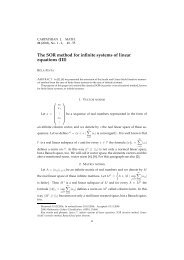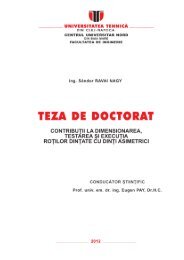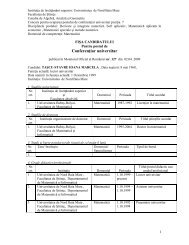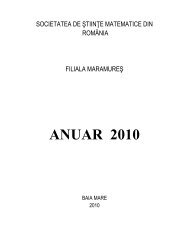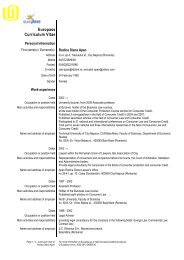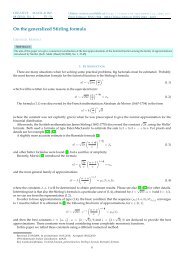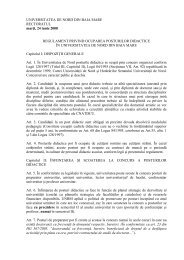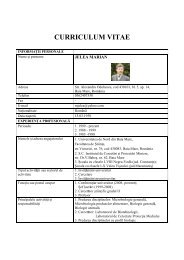On the generalized Stirling formula - Creative Math. and Inf.
On the generalized Stirling formula - Creative Math. and Inf.
On the generalized Stirling formula - Creative Math. and Inf.
- No tags were found...
Create successful ePaper yourself
Turn your PDF publications into a flip-book with our unique Google optimized e-Paper software.
CREATIVE MATH. & INF.19 (2010), No. 1, 53 - 56<strong>On</strong>line version at http://creative-ma<strong>the</strong>matics.ubm.ro/Print Edition: ISSN 1584 - 286X <strong>On</strong>line Edition: ISSN 1843 - 441X<strong>On</strong> <strong>the</strong> <strong>generalized</strong> <strong>Stirling</strong> <strong>formula</strong>CRISTINEL MORTICIABSTRACT. The aim of this paper is to give a numerical construction of <strong>the</strong> best approximations of<strong>the</strong> factorial function among <strong>the</strong> family of approximations introduced by Mortici [Arch. <strong>Math</strong>. (Basel)93 (2009), No. 1, 37-45].1. INTRODUCTIONThere are many situations when for solving some practical problems, big factorialsmust be estimated. Probably <strong>the</strong> most known estimation <strong>formula</strong> for <strong>the</strong>factorial function is <strong>the</strong> <strong>Stirling</strong>’s <strong>formula</strong>:n! ∼ √ ( n) n2πn(1.1)ewhich will be written for some reasons in <strong>the</strong> equivalent form:n! ∼ √ ( n) n+ 122πe = σ n . (1.2)eThe <strong>formula</strong> (1.1) was discovered by <strong>the</strong> French ma<strong>the</strong>matician Abraham deMoivre (1667-1754) in <strong>the</strong> form( n) n √n! ∼ k ne(where <strong>the</strong> constant was not explicitly given) when he was preoccupied to give<strong>the</strong> normal approximation for <strong>the</strong> binomial distribution.Afterwards, <strong>the</strong> Scottish ma<strong>the</strong>matician James <strong>Stirling</strong> (1692-1770) discovered<strong>the</strong> constant √ 2π, using <strong>the</strong> Wallis’ <strong>formula</strong>. Both used a <strong>formula</strong> of type Euler-MacLaurin to estimate <strong>the</strong> sum ln 2 + ln 3 + ... + ln n. For proofs <strong>and</strong> details seefor example [13]-[15].A slightly more accurate estimate is <strong>the</strong> Burnside <strong>formula</strong> [1]:n! ∼ √ 2π( n +1)n+ 1 22= β n (1.3)e<strong>and</strong> o<strong>the</strong>r better <strong>formula</strong>s were found [2], but a sacrifice of simplicity.Recently, Mortici [3] introduced <strong>the</strong> <strong>formula</strong>√ ( ) n+ 12π n + 12n! ∼= αne eReceived: 23.09.2009. In revised form: 18.01.2010. Accepted: 08.02.2010.1991 Ma<strong>the</strong>matics Subject Classification. 40A25.Key words <strong>and</strong> phrases. Factorial function, gamma function, <strong>Stirling</strong>’s <strong>formula</strong>, Burnside’s <strong>formula</strong>.53
54 C. Mortici<strong>and</strong> <strong>the</strong> more general family of approximations( ) n+b n + an! ∼ λ= µ n (λ, a, b), (1.4)ewhere <strong>the</strong> constants λ, a, b will be determined to obtain performant results. Pleasesee also [3]-[12] for o<strong>the</strong>r details. Interesting fact is that also <strong>the</strong> <strong>Stirling</strong>’s <strong>formula</strong>is a particular case of (1.4), obtained for λ = √ 2πe, a = 0 <strong>and</strong> b = 1/2, as we cansee from <strong>the</strong> representation (1.2).In order to have approximations of type (1.4), <strong>the</strong> basic condition that <strong>the</strong> sequence(µ n (λ, a, b)/n!) n≥1converges to 1 must be fulled. It is obtained in [3] <strong>the</strong>following final form of approximations, for x ∈ [0, 1] ,n! ∼ √ ( ) n+ 1n + x2πe · e −x 2= µn (x),e<strong>and</strong> <strong>the</strong>n <strong>the</strong> best constants x ∈ {ω, ζ} , ω = ( 3 − √ 3 ) /6 <strong>and</strong> ζ = ( 3 + √ 3 ) /6are deduced to provide <strong>the</strong> best approximations. These constants were foundconsidering some completely monotonic functions.In this paper we refind <strong>the</strong>se constants using a different numerical method.2. THE RESULTSThe function µ n (x) is strictly increasing on [0, 1/2] <strong>and</strong> strictly decreasing on[1/2, 1] , becauseddx (ln µ n(x)) =12 − xx + n ,so a direct consequence is that µ n (0) < n! < µ n (1/2) > n! > µ n (1), orσ n < n! < β n > n! > α n . (2.5)By <strong>the</strong> inequalities (2.5) <strong>and</strong> by continuity arguments on <strong>the</strong> function µ n (x), itresults that <strong>the</strong>re exists a sequence (w n ) n≥1⊂ (0, 1/2) such that µ n (w n ) = n!,which isn! = √ ( ) n+ 1n + wn22πe · e −wn e<strong>and</strong> <strong>the</strong>re exists a sequence (z n ) n≥1⊂ (1/2, 1) such that f(z n ) = n!, orn! = √ ( ) n+ 1n + zn22πe · e −zn .eAfter some numerical computations, we deduced that <strong>the</strong> sequences (w n ) n≥1<strong>and</strong>(z n ) n≥1are decreasing, so <strong>the</strong>y are convergent to w = 0.21133..., respective toz = 0.78868... . Now we have obtained <strong>the</strong> following under-approximation <strong>and</strong>upper-approximation <strong>formula</strong>s for <strong>the</strong> factorial function:( )√ n+ 1(2πe·e−0.21133... n + 0.21133...2 √< n! < 2πe·e−0.78868... n+0.78868...ee) n+ 12.
<strong>On</strong> <strong>the</strong> <strong>generalized</strong> <strong>Stirling</strong> <strong>formula</strong> 55Fur<strong>the</strong>r, we remark that w + z ≈ 1 <strong>and</strong> wz ≈ 1/6, so we take w = (3 − √ 3)/6 <strong>and</strong>z = (3 + √ 3)/6 to obtain <strong>the</strong> approximations:ω n = √ (√3 n +3− √ ) n+ 13 22π·e 66< n! < √ (2π·e −√ 3 n +3+ √ ) n+ 13 266= ζ n . (2.6)ee3. CONCLUDING REMARKSIn <strong>the</strong> final part, we expose <strong>the</strong> idea for obtaining new, stronger approximations.To be more exactly, if we replace <strong>the</strong> approximations (2.6) by <strong>the</strong>ir geometricmean, <strong>the</strong>n we obtain <strong>the</strong> following much more accurate estimation:n! ≈ √ 2π( n 2 + n + 1 6e 2 ) n 2 + 1 4= µ n . (3.7)<strong>On</strong>e way to compare <strong>the</strong> accurateness of some approximations is to introduce <strong>the</strong>number of exact decimal digits function (edd), by <strong>the</strong> <strong>formula</strong>edd(n) = − lg∣ 1 − approx(n)n! ∣ ,where approx(n) is <strong>the</strong> respective approximation. We take into account <strong>the</strong> approximation<strong>formula</strong>s α n from (2.5), ω n <strong>and</strong> ζ n from (2.6), <strong>the</strong> <strong>Stirling</strong>’s <strong>formula</strong>σ n from (1.2), <strong>the</strong> Burnside’s <strong>formula</strong> β n from (1.3) <strong>and</strong> <strong>the</strong> following <strong>formula</strong>from [2] due to R. W. Gosper:√ (γ n = 2n + 1 ( n) nπ · .3)eAs we can see, <strong>the</strong> most accurate is our <strong>formula</strong> µ n from (3.7), while only <strong>the</strong>Gosper’s <strong>formula</strong> provides comparable results with our new <strong>formula</strong>s ω n <strong>and</strong> ζ n .nedd(n)σ n α n β n ω n ζ n γ n µ n50 6.3978 6.4176 7.0996 12.660 12.680 12.804 17.247100 7.0905 7.1004 7.7880 14.041 14.051 14.185 19.311250 8.0065 8.0105 8.7014 15.871 15.875 16.015 22.0511000 9.3927 9.3937 10.086 18.642 18.643 18.786 26.205Finally, note that if <strong>the</strong> <strong>Stirling</strong>’s <strong>formula</strong> gives 1000! with <strong>the</strong> first 9 exact decimals<strong>and</strong> Gosper’s <strong>formula</strong> gives <strong>the</strong> same result with 18 exact decimals, <strong>the</strong>nour <strong>formula</strong> µ n provides <strong>the</strong> value of 1000! with 26 exact decimals.REFERENCES[1] Burnside, W., A rapidly convergent series for log N!, Messenger <strong>Math</strong>. 46 (1917), 157-159[2] Gosper, R. W., Decision procedure for indefinite hypergeometric summation, Proc. Natl. Acad. Sci. 75(1978), 40–42[3] Mortici, C., An ultimate extremely accurate <strong>formula</strong> for approximation of <strong>the</strong> factorial function, Arch.<strong>Math</strong>. 93 (2009), No. 1, 37-45[4] Mortici, C., Product approximations via asymptotic integration, Amer. <strong>Math</strong>. Monthly 117 (2010),No. 5, 434-441
56 C. Mortici[5] Mortici, C., New approximations of <strong>the</strong> gamma function in terms of <strong>the</strong> digamma function, Appl. <strong>Math</strong>.Lett. 23 (2010), No. 1, 97-100[6] Mortici, C., New sharp bounds for gamma <strong>and</strong> digamma functions, An. Ştiinţ. Univ. A. I. Cuza IaşiSer. N. Matem. 56, No. 2 (in press)[7] Mortici, C., Complete monotonic functions associated with gamma function <strong>and</strong> applications,Carpathian J. <strong>Math</strong>. 25 (2009), No. 2, 186-191[8] Mortici, C., Optimizing <strong>the</strong> rate of convergence in some new classes of sequences convergent to Euler’sconstant, Anal. Appl. (Singap.) 8 (2010), No. 1, 1-9[9] Mortici, C., Improved convergence towards <strong>generalized</strong> Euler-Mascheroni constant, Appl. <strong>Math</strong>. Comput.215 (2010), 3443-3448[10] Mortici, C., A class of integral approximations for <strong>the</strong> factorial function, Comput. <strong>Math</strong>. Appl. (2010),DOI: 10.1016/j.camwa.2009.12.010[11] Mortici, C., Best estimates of <strong>the</strong> <strong>generalized</strong> <strong>Stirling</strong> <strong>formula</strong>, Appl. <strong>Math</strong>. Comput. 215 (2010), No.11, 4044-4048[12] Mortici, C., <strong>On</strong> new sequences converging towards <strong>the</strong> Euler-Mascheroni constant, Comput. <strong>Math</strong>.Appl. (2010), DOI: 10.1016/j.camwa.2010.01.029[13] O’Connor, J. <strong>and</strong> Robertson, E. F., James <strong>Stirling</strong>, MacTutor History of Ma<strong>the</strong>matics Archive[14] Qin, X. <strong>and</strong> Su, Y.,Viscosity approximation methods for nonexpansive mappings in Banach spaces,Carpathian J. <strong>Math</strong>. 22 (2006), No. 1-2, 163-172[15] <strong>Stirling</strong>, J., Methodus differentialis, sive tractatus de summation et interpolation serierum infinitarium,London, 1730. English translation by J. Holliday, The Differential Method: A Treatise of <strong>the</strong> Summation<strong>and</strong> Interpolation of <strong>Inf</strong>inite SeriesDEPARTMENT OF MATHEMATICSVALAHIA UNIVERSITY OF TÂRGOVIŞTEUNIRII 18, 130082 TÂRGOVIŞTEE-mail address: cmortici@valahia.roE-mail address: cristinelmortici@yahoo.com



